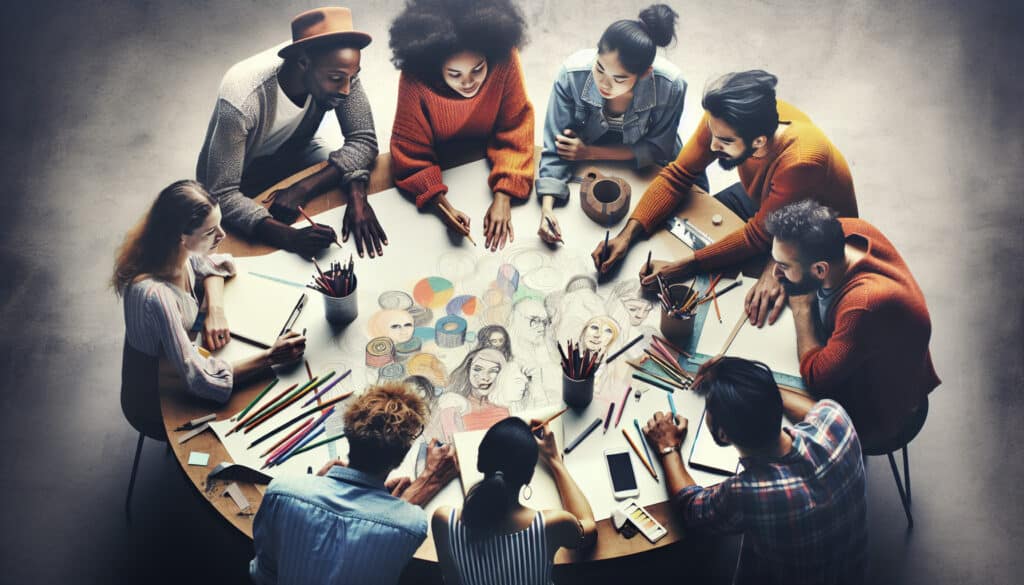A design activity where multiple participants create sketches together to explore and communicate ideas visually.
- Methodologies: Customers & Marketing, Ideation, Product Design
Collaborative Sketching

Collaborative Sketching
- Brainstorming, Design Thinking, Human-Centered Design, Interaction Design, Prototyping, User experience (UX), User Interface (UI), Visual Design
Objective:
How it’s used:
- In a workshop setting, team members or users collectively draw concepts for a user interface, workflow, or product, building on each other's visual ideas in real-time.
Pros
- Encourages participation from everyone, regardless of drawing skill; generates a wide range of ideas quickly; and creates a shared visual understanding of concepts.
Cons
- Can be chaotic without good facilitation, may be intimidating for non-visual thinkers, and the focus is on ideation, not detailed design.
Categories:
- Ideation, Product Design
Best for:
- Rapidly generating and exploring design ideas in a group setting to create a shared vision.
Collaborative Sketching finds significant applications across various industries including technology, consumer products, healthcare, and education, functioning effectively during the early phases of product development and design thinking workshops. In environments where rapid ideation is necessary, such as during design sprints or brainstorming sessions, team members, including designers, engineers, project managers, and even end users, come together to visualize ideas, blending their diverse expertise to create solutions that address real user needs. This methodology is particularly advantageous when developing user interfaces and workflows, as it allows participants to iterate designs based on immediate feedback, refining concepts in real time. By engaging everyone in the sketching process, organizations can break down communication barriers, harnessing the collective creativity and knowledge of the group while ensuring that the visual outcomes are aligned with user expectations. This approach is not limited to formal workshops; it can also be implemented in informal settings or remote collaboration tools, where digital sketching applications facilitate participation across different locations. As a result, teams can explore and fine-tune ideas quickly, leading to innovative solutions that benefit from the diverse perspectives and ideas generated during the sketching sessions.
Key steps of this methodology
- Set a clear design objective for the session.
- Introduce drawing tools and materials for all participants.
- Initiate the sketching process with one person drawing a design idea.
- Encourage others to build upon the initial drawing with additional elements or modifications.
- Rotate drawing responsibilities among participants to involve everyone.
- Facilitate discussions around sketches to clarify intentions and ideas.
- Utilize a timer for rapid sketching sessions to maintain momentum.
- Record and document the evolving sketches for future reference.
- End the session with a review of the created sketches to consolidate ideas.
Pro Tips
- Utilize sticky notes alongside sketching to capture and prioritize ideas without interrupting the flow of drawing.
- Assign a facilitator to ensure balanced participation and to synthesize the group's output into coherent themes.
- Incorporate time constraints for each sketching round to encourage quick ideation and prevent overthinking.
To read and compare several methodologies, we recommend the
> Extensive Methodologies Repository <
together with the 400+ other methodologies.
Your comments on this methodology or additional info are welcome on the comment section below ↓ , so as any engineering-related ideas or links.
Historical Context
1949
1950
1950
1960
1960
1960
1960
1940
1950
1950
1958
1960
1960
1960
1960
(if date is unknown or not relevant, e.g. "fluid mechanics", a rounded estimation of its notable emergence is provided)















Related Posts
Manufacturing Operations Management (MOM)
Manufacturing Execution System (MES)
Manufacturing Control Plan
Manual Testing
Manual Handling Assessment Charts (MAC)
ManTRA (Manual Tasks Risk Assessment Tool)